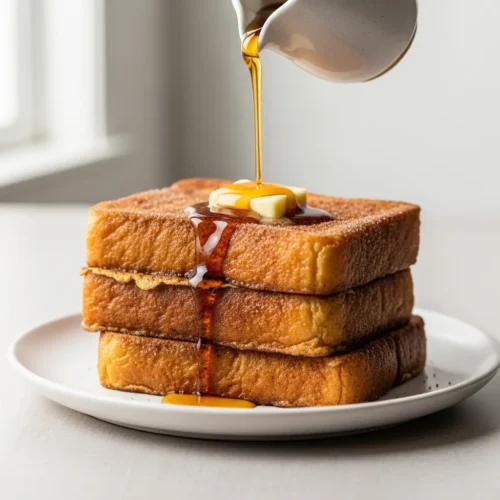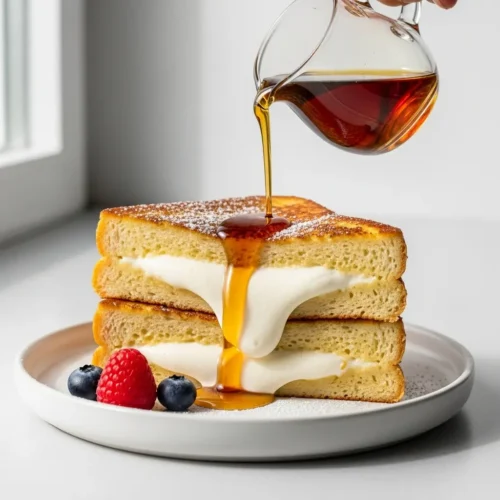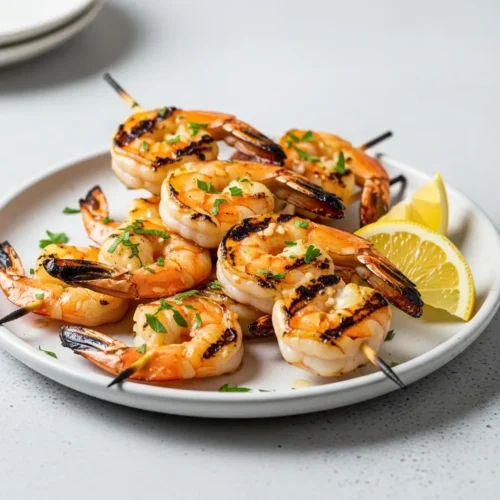Forget everything you thought you knew about French toast. This is the ultimate challah french toast recipe that will transform your weekend brunch forever. Imagine thick, fluffy slices of rich challah bread, soaked in a sweet, cinnamon-vanilla custard, and pan-fried to golden-brown perfection. The outside is slightly crisp, while the inside remains unbelievably soft, custardy, and decadent. This isn’t just breakfast; it’s an experience.
We’ve tested every variable to ensure this recipe is foolproof. Say goodbye to soggy centers and burnt edges. Get ready to create the most luxurious, restaurant-quality French toast right in your own kitchen.
Why This is the Best Challah French Toast Recipe
What makes this recipe stand out? It’s all about the details. We focus on three key things: the perfect bread, a balanced custard, and the right cooking technique.
- Unbeatable Texture: Using challah bread creates a rich, tender crumb that soaks up the custard without falling apart, resulting in a dreamy, bread-pudding-like interior.
- Perfectly Balanced Custard: Our specific egg-to-dairy ratio creates a custard that’s rich but not overly “eggy,” with just the right amount of sweetness and warm spice from cinnamon and a hint of nutmeg.
- No More Soggy Centers: We’ll share the secrets to achieving a perfectly cooked slice every time, ensuring a beautiful golden crust and a fully cooked, custardy middle.
Why Challah is the Perfect Bread for French Toast
While many breads work, challah is in a league of its own. It’s an enriched bread, made with eggs and oil, giving it a wonderfully rich flavor and a tight, plush crumb. This structure is key. It’s sturdy enough to handle a good soak in the custard bath but tender enough to melt in your mouth.
For the absolute best results, use day-old or slightly stale challah. Stale bread is drier, which allows it to absorb more of the flavorful custard without becoming mushy. This is the single most important tip for avoiding soggy French toast!
Key Ingredients for Success
The beauty of this recipe is in its simplicity. You only need a few high-quality ingredients to achieve brunch perfection. Using full-fat dairy and real vanilla makes a noticeable difference in the final flavor and texture.

- Challah Bread: The star of the show. Use a 1-pound loaf, preferably a day or two old. Slice it into thick, 1-inch slices.
- Large Eggs: They form the rich base of our custard.
- Whole Milk & Heavy Cream: A combination of milk and cream provides the perfect balance of moisture and decadent richness. You can use all milk, but the cream adds a luxurious touch.
- Granulated Sugar: Just a touch to sweeten the custard. Most of the sweetness will come from your toppings.
- Vanilla Extract: Use pure vanilla extract for the best warm, aromatic flavor.
- Ground Cinnamon & Nutmeg: These warm spices are classic in French toast and complement the eggy bread beautifully.
- Salt: A pinch of salt enhances all the other flavors.
- Unsalted Butter: For frying. It adds flavor and helps create that perfect golden-brown crust.
How to Make Challah French Toast (Step-by-Step)
This process is simple and rewarding. The key is to work efficiently and not overcrowd the pan. Prepare your custard, soak the bread, and pan-fry to perfection.
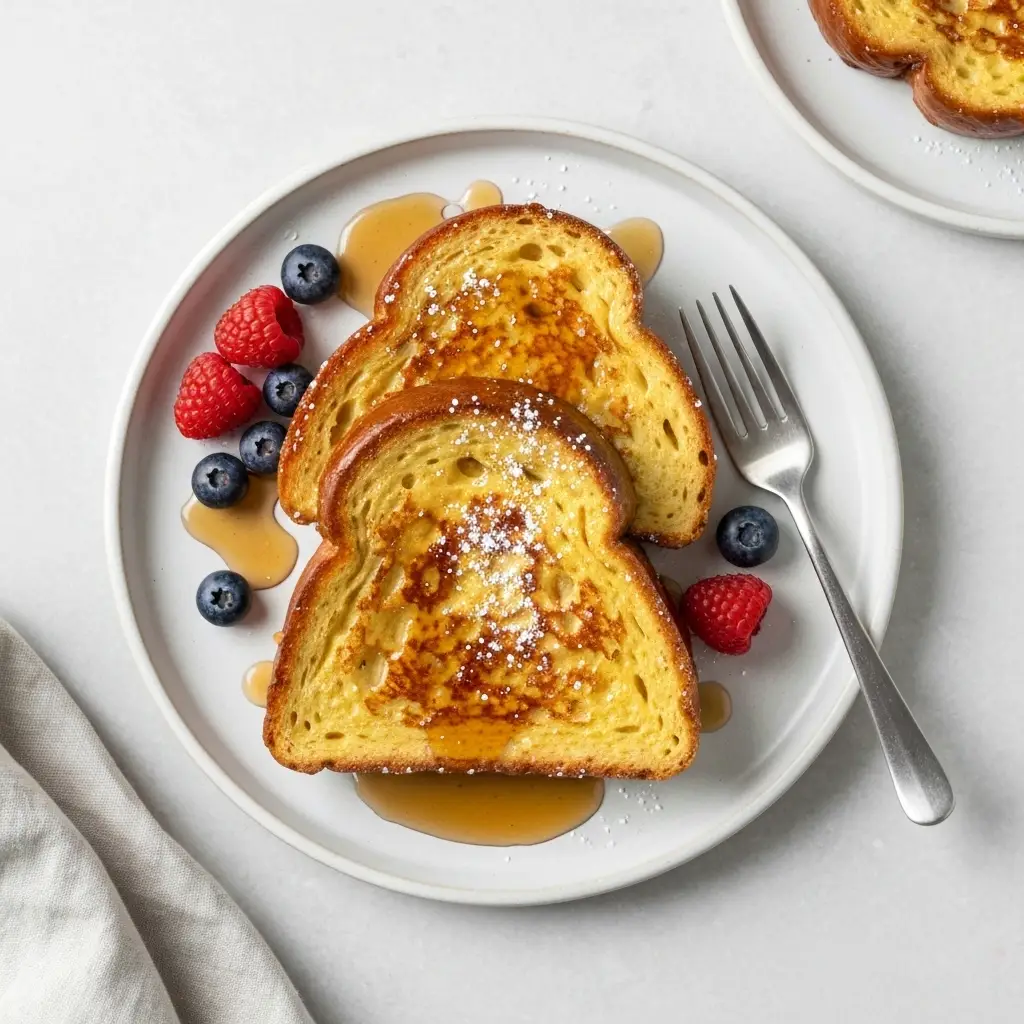
- Prepare the Custard: In a large, shallow dish (a pie plate or 9×13 inch baking dish works perfectly), whisk together the eggs, milk, heavy cream, sugar, vanilla, cinnamon, nutmeg, and salt. Whisk until the mixture is completely smooth and uniform in color with no visible streaks of egg yolk.
- Soak the Challah: Place the thick slices of challah into the custard mixture in a single layer. Let them soak for about 20-30 seconds per side. You want the bread to be saturated but not falling-apart soggy. The bread should feel heavy with the custard.
- Heat the Pan: While the bread is soaking, place a large non-stick skillet or griddle over medium-low heat. Add 1 tablespoon of butter and let it melt and bubble slightly.
- Cook the French Toast: Carefully lift a slice of soaked challah from the custard, allowing any excess to drip off. Place it in the hot skillet. Cook for 3-4 minutes per side, until deep golden brown and crisp. The center should be cooked through and spring back when gently pressed.
- Serve Immediately: Transfer the cooked French toast to a plate and serve immediately with your favorite toppings like maple syrup, powdered sugar, and fresh berries. Repeat with the remaining slices, adding more butter to the pan as needed.
Tips for a Perfect Custard-Like Interior
Achieving that glorious texture is an art, but these tips make it easy.
The Golden Egg-to-Dairy Ratio
For a truly custardy French toast, the balance is crucial. We use 4 large eggs to 1 1/4 cups of dairy. This ensures the mixture is rich enough to create a soft interior without being overly eggy or watery.
Don’t Over-Soak (But Don’t Under-Soak!)
The perfect soak time is about 20-30 seconds per side for 1-inch thick, day-old challah. This is long enough for the custard to penetrate the center but not so long that the bread’s structure breaks down. If your bread is very fresh, reduce the soaking time slightly.
Medium-Low Heat is Your Friend
Cooking French toast on high heat is a common mistake. It causes the outside to burn before the custard in the center has a chance to cook, leading to a raw, soggy middle. Cooking on medium-low heat allows the slice to heat through evenly, setting the custard perfectly while developing a beautiful, uniform crust.
Creative Topping and Serving Ideas
While classic maple syrup is always a winner, this challah French toast is a perfect canvas for all sorts of delicious toppings. Here are a few ideas to get you started:
| Style | Topping Combination |
|---|---|
| Classic & Simple | Butter, pure maple syrup, and a dusting of powdered sugar. |
| Fresh & Fruity | Mixed berries (strawberries, blueberries, raspberries), sliced bananas, and a dollop of whipped cream or Greek yogurt. |
| Warm & Spiced | Sautéed cinnamon apples, a sprinkle of pecans, and a drizzle of caramel sauce. |
| Rich & Decadent | A spread of Nutella, sliced bananas, and chopped hazelnuts. Perfect for a dessert-for-breakfast moment. |
Storage, Freezing, and Reheating Instructions
Made too much? No problem! This French toast reheats beautifully.
Storing Leftovers
Allow the French toast to cool completely, then store it in an airtight container in the refrigerator for up to 3 days.
How to Freeze French Toast
For longer storage, flash-freeze the cooled slices on a baking sheet for an hour. Once solid, transfer them to a zip-top freezer bag, placing a piece of parchment paper between each slice to prevent sticking. They will keep for up to 2 months.
The Best Way to Reheat
For the best texture, avoid the microwave! Reheat leftover French toast in a toaster or a 350°F (175°C) oven for 5-10 minutes until hot and re-crisped. You can also reheat them in a lightly buttered skillet over medium-low heat.
More Breakfast Recipes You’ll Love
If you loved this recipe, you’re sure to enjoy these other brunch favorites. For a different but equally delicious option, try our fluffy brioche French toast. If you’re feeding a crowd, this make-ahead French toast casserole is a lifesaver. And for a truly decadent treat, you can’t go wrong with our classic stuffed French toast.
The Ultimate Challah French Toast Recipe
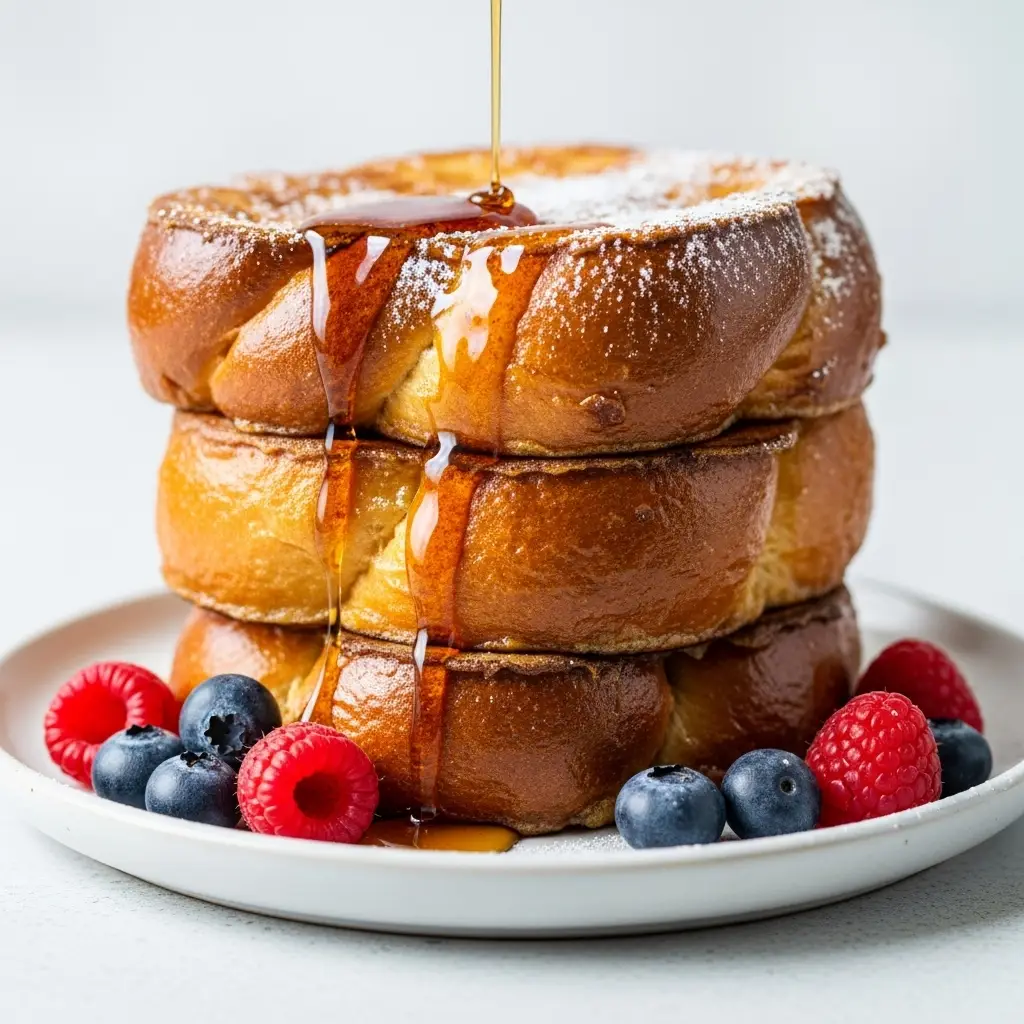
Challah French Toast Recipe: The Ultimate Guide to Perfect Brunch
Ingredients
Equipment
Method
- In a large, shallow dish, whisk together the eggs, whole milk, heavy cream, granulated sugar, vanilla extract, cinnamon, nutmeg, and salt until fully combined and smooth.
- Working in batches, place the challah slices in the custard mixture and let them soak for 20-30 seconds per side, until saturated but not falling apart.
- Melt 1 tablespoon of butter in a large non-stick skillet or on a griddle over medium-low heat until it’s shimmering.
- Lift a slice of soaked challah from the custard, allowing the excess to drip back into the dish. Place it in the hot pan and cook for 3-4 minutes per side, until a deep golden brown and the center is cooked through.
- Repeat with the remaining slices, adding more butter to the pan as needed. Serve immediately with your favorite toppings.
Notes
Don’t Overcrowd the Pan: Cook only 2-3 slices at a time to maintain the pan’s temperature and ensure the slices get a nice, even crust.
Keep it Warm: If you’re cooking for a crowd, you can keep the finished French toast warm in a 200°F (95°C) oven on a baking sheet while you cook the remaining batches.
Frequently Asked Questions
To avoid a soggy middle, use stale, thick-cut bread, don’t over-soak it (20-30 seconds per side is enough), and most importantly, cook it on medium-low heat. Low and slow cooking allows the custard in the center to cook through completely before the outside burns.
You should always use day-old or slightly stale challah. Stale bread is drier, which allows it to absorb more of the egg and milk mixture without becoming mushy. This is the most important secret to preventing soggy French toast.
The best way to reheat French toast is in a toaster, a toaster oven, or a conventional oven preheated to 350°F (175°C). This will make the outside crispy again while warming the inside. You can also reheat it in a lightly buttered skillet. We recommend avoiding the microwave, as it can make the toast soggy.
Challah is an enriched bread made with eggs, which gives it a rich flavor and a sturdy, yet tender, texture. Its dense crumb is perfect for soaking up custard without falling apart, resulting in a soft, custardy interior and a beautifully golden exterior.
Share Your Brunch Masterpiece!
We’re confident this will become your go-to challah french toast recipe. There’s nothing better than sharing a delicious, comforting meal with people you love. If you make this recipe, please leave a comment below and let us know how it turned out! We’d also love for you to share your creations on Pinterest!
